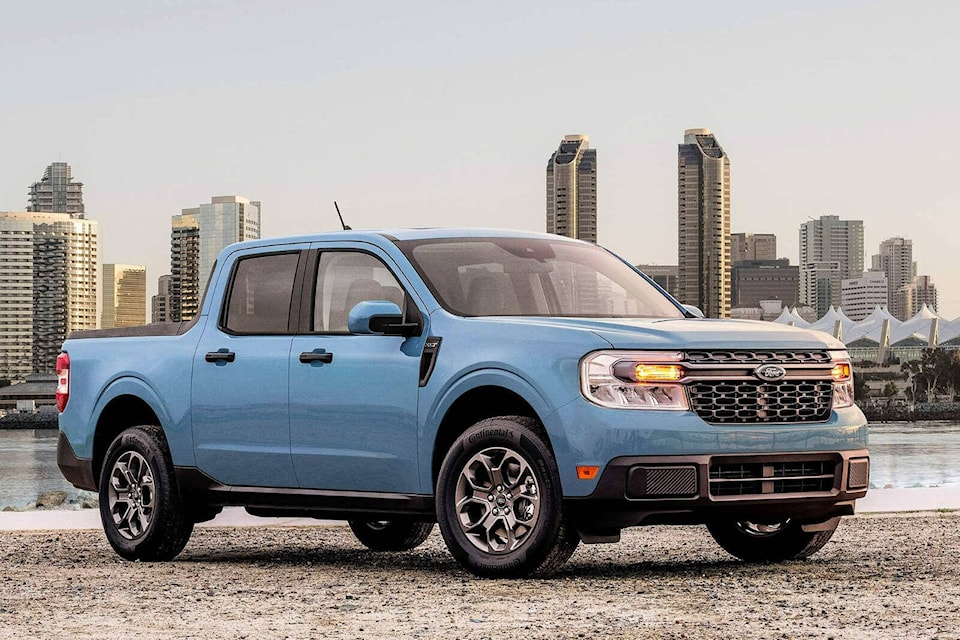Ford had the small-truck market all to itself with the original Ford Ranger, until it was retired following the 2011 model year. The Ranger badge reappeared on a midsize pickup for 2019, but apparently there’s room in the lineup for a still-smaller trucklet.
If the Maverick name sounds familiar, it’s because Ford once applied it to a small car in the late-1960s. Back then, it was the most affordable Ford you could buy. Well, the same goes for the 2022 Maverick, which on price alone is bound to garner plenty of attention from both traditional and nontraditional pickup buyers. It’s just about the cheapest Ford you can buy, next to the EcoSport subcompact crossover.
For nontraditional buyers, especially, the Maverick’s SuperCrew (crew cab) body style with four full doors and seating for five passengers makes it family-friendly and practical. The 4.5-foot-long bed is about six inches (15 centimetres) longer than the one connected to the 2022 Hyundai Santa Cruz pickup. It’s also slightly longer than the Honda Ridgeline’s bed floor. Ford claims the Maverick can carry 18 4x8 sheets of three-quarter-inch plywood flat on the load floor, but with the tailgate lowered, of course.

The Maverick’s platform originates with the unitized (frameless) Ford Bronco Sport and Escape crossovers. For pickup duty, it has been strengthened in key areas to accommodate payloads of up to a healthy 1,500 pounds (682 kilograms).
The styling has nothing in common with the Escape, but the Maverick does display some resemblance to the full-size F-150 pickup, in particular its grille and headlights.
The interior gives off a minimalist vibe that fits nicely with the Maverick’s purpose in life and its base price is below the $30,000 threshold in Canada. Knobs and buttons control most functions, including the audio and ventilation systems plus there’s oversize rotary control for gear selection. Even the gauges and standard 8.0-inch touch-screen are merely functional, along with a rear-seat cushion that flips up to reveal storage bins for valuables.
The standard hybrid powertrain is as unique as the Maverick itself. A 2.5-litre four-cylinder is teamed with an electric motor to produce a net 191 horsepower and 155 pound-feet of torque. It comes with a continuously variable transmission.

Optional with all trim levels is a non-hybrid powertrain: A turbocharged 2.0-litre four-cylinder with 250 horsepower and 277 pound-feet is mated to an eight-speed automatic transmission.
All-wheel-drive is available with the 2.0. The system lacks a two-speed transfer case, which means there’s no low range for more extreme off-roading.
The hybrid can tow up to 2,000 pounds (909 kilograms), while the 2.0-litre is rated at 4,000 pounds (1,820 kilograms) and is fitted with a factory towing package. That’s less than the maximum 5,000 pounds (2,270 kilograms) that both the Santa Cruz and Ridgeline can pull.
Where the hybrid really shines is fuel consumption, or lack therof. The unofficial rating is 5.6 l/100 km in the city, 7.1 on the highway and 6.3 combined. The turbo powerplant is rated at 10.7/8.1/9.6.
The base Maverick XL rings in at $28,000, including destination charges. The standard-equipment list is pretty thin — think work truck, here — and does not include cruise control.
The midgrade XLT, which is likely to be the jumping-off point for most buyers, gets cruise control plus upgraded seat coverings, rear-seat armrest, heated steering wheel, power-locking tailgate and 17-inch alloy wheels. Steel wheels are standard.
The top-end Lariat lists for $36,550 and comes with dual-zone climate control, leather seat surfaces (including power driver’s seat), power-sliding rear window and 18-inch wheels.
The FX4 Off-Road Package is available for all Mavericks with all-wheel-drive. With it you get protective skid plates, higher-capacity radiator and unique aluminum wheels with all-terrain tires. There’s also hill-descent control that keeps the Maverick at a slow and steady pace when heading down steep inclines, without the driver having to use the brakes.
As a utility-vehicle alternative, the Maverick possesses numerous virtues, such as the ability to haul heavy/bulky cargo. As such, it could become a hero of urban job sites or a new tool for delivery companies.
Factor in the hybrid’s modest fuel consumption plus a tempting sticker price and both trucker and nontrucker types could be climbing aboard.

What you should know: 2022 Ford Maverick
Type: Front- /all-wheel-drive compact pickup truck
Engines (h.p.): 2.5-litre I-4 plus electric motor (191); 2.0-litre I-4, turbocharged (250)
Transmissions: Continuously variable (2.5); eight-speed automatic (2.0)
Market position: Ford is back in the compact-pickup bracket after more than decade. The Hyundai Santa Cruz is the only true competitor, but it’s significantly different and has a much higher base price.
Points: Neatly styled and packaged small truck. • Interior has plain, uncomplicated controls. • Base hybrid is a total fuel-sipper while the optional turbo I-4 does the heavy lifting. • Base version is well-priced, but lacks most available active-safety tech. • If any pickup can attract non-traditional buyers, this is likely it.
Driver assist: Blind-spot warning with cross-traffic backup alert (opt.); active cruise control (opt.); front emergency braking (std.); inattentive-driver alert (n.a); lane-departure warning (opt.); pedestrian detection (n.a.)
L/100 km (city/hwy): 5.6/7.1 (hybrid)
Base price (incl. destination): $28,000
BY COMPARISON
Hyundai Santa Cruz
- Base price: $40,450
- Sleek little hauler looks good, but cargo bed is on the small side. AWD is std.
Honda Ridgeline
- Base price: $47,500
- Larger four-door pickup is equipped with a 280-horsepower V-6. AWD is std.
Toyota Tacoma
- Base price: $40,300
- Midsize truck is available in extended and crew-cab models. AWD is std.
– written by Malcom Gunn, Managing Partner at Wheelbase Media
If you’re interested in new or used vehicles, be sure to visit TodaysDrive.com to find your dream car today! Like us on Facebook and follow us on Instagram
